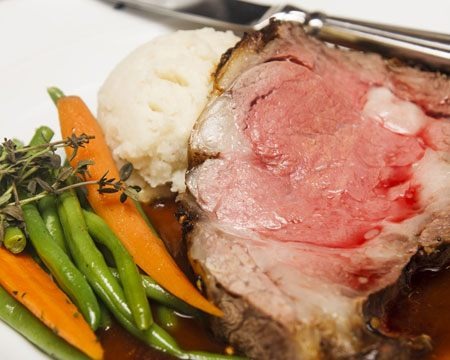Roast Rib Of Beef
Roast Rib Of Beef
This recipe is minimal, relying on the qualities of the meat to cook it perfectly. The ribs of the beef are great conductors of heat and the layer of fat not only serves as an additional component of flavor, but helps to baste the beef as well. Because of the many flavorful aspects of the beef alone in this recipe, very few additional ingredients are required to make it a standout dish.
Servings
6
servings

Ingredients
- one 5- to 6-pound rib of beef, on the bone
- 1 teaspoon english mustard powder
- 1 teaspoon all-purpose flour
- salt and pepper, to taste
- 1 onion, halved
Directions
- Pre-heat the oven to, 400 degrees.
- Dust the fat surface of the beef with 1 level dessertspoon each of the English mustard powder and plain flour — just rub them in gently — then season with salt and pepper.
- Place the joint in a roasting tin on top of 2 small halves of onion. The onion will caramelize as the beef cooks and give a lovely flavor and color to the gravy. Now place the meat on a tray just above the center of the oven. It will have plenty of fat so don't add extra. Give it 20 minutes of cooking at the initial temperature; after that turn the heat down to 325 degrees and cook it for 15 minutes to the pound — this will give you rare beef. Add 15 minutes to the total cooking time for medium rare and 30 minutes for well done.
- While the beef is cooking, lift it out of the oven from time to time, tilt the tin and baste the meat really well with its own juices — this ensures that the flavor that is concentrated in the fat keeps permeating the meat, and at the same time the fat keeps everything moist and succulent. While you're basting, close the oven door in order not to lose heat. Baste the meat with the juices at least three times during cooking.
- To see if the beef is cooked to your liking, insert a thermometer into the thickest part of the joint and check the temperature. The temperature will indicate how much the beef has cooked. When it is cooked to your liking, remove it from the oven, transfer it to a board, and allow it to stand in a warm place for up to an hour, loosely covered with foil, before carving — to let all the precious juices that have bubbled up to the surface seep back into the flesh. Also, as the meat relaxes it will be easier to carve. Some of the juices will escape, though, and these should be poured into the gravy.
- 110 degrees F = Rare 125 degrees F = Medium-Rare 135 degrees F = Medium 160 degrees F = Well Done